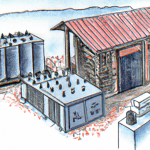Crop Rotation for Soil Health
In today’s world of convenience and instant gratification, many people have become disconnected from the land and the importance of self-reliance. However, as we face an uncertain future with potential crisis or disaster looming, it is crucial now more than ever to learn and practice self-sustainable skills. One essential skill that every homesteader, survivalist, and self-reliant individual should know is crop rotation. In this article, we will explore the benefits of crop rotation and why it is vital for maintaining soil health.
Preserving Soil Fertility
Soil, the foundation of our food production, is a precious resource that requires careful management. Years of continuous cropping without proper rotation can deplete the soil of essential nutrients, leading to decreased yields and poor plant health. Crop rotation helps preserve soil fertility by:
- Breaking Pest and Disease Cycles: Different crops attract different pests and diseases. By rotating crops, you can disrupt the life cycles of these harmful organisms, reducing the need for chemical intervention and promoting a healthier, more balanced ecosystem.
- Improving Soil Structure: Different plants have different root structures, some of which are better at breaking up compacted soil or adding organic matter. By rotating crops, you can improve soil structure, allowing for better water infiltration, root penetration, and overall soil health.
- Nutrient Cycling: Different crops have varying nutrient requirements and uptake patterns. By rotating crops, you can ensure that soil nutrients are utilized more efficiently, reducing the risk of nutrient imbalances and minimizing the need for synthetic fertilizers.
Reducing Soil Erosion
Soil erosion is a significant issue that can lead to the loss of topsoil, which is rich in organic matter and essential nutrients. Crop rotation can help combat soil erosion in the following ways:
- Improved Ground Cover: Some crops, such as legumes or cover crops, have a dense growth habit that can cover and protect the soil, reducing erosion caused by wind and water.
- Reduced Water Runoff: Different crops have different water requirements. By planting crops with varying water needs in rotation, you can prevent excessive irrigation or water runoff, minimizing the risk of erosion.
Preventing Weed Competition
Weeds can be a persistent problem in agriculture, quickly overtaking crops and reducing yields. Crop rotation can aid in weed control by:
- Disrupting Weed Life Cycles: Just like pests and diseases, weeds have life cycles that can be disrupted through crop rotation. By planting crops that naturally suppress or outcompete weeds, you can reduce weed pressure without resorting to herbicides.
- Altering Soil Conditions: Different crops have different soil pH requirements. By rotating crops, you can create fluctuations in soil pH, making it less conducive for certain weed species.
Conclusion
Crop rotation is not a new concept; it is a tried and tested farming technique that has been used for centuries. By incorporating crop rotation into your gardening or farming practices, you can ensure the long-term health and productivity of your soil. In a world where self-reliance is becoming increasingly critical, learning these traditional farming methods can provide a sense of security and the ability to sustain ourselves in times of crisis. Don’t wait for disaster to strike; start implementing crop rotation today and reap the benefits of healthy, fertile soil for years to come.




GIPHY App Key not set. Please check settings